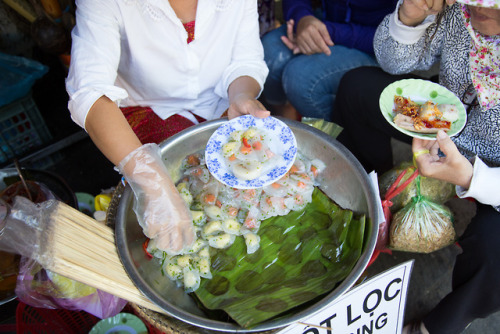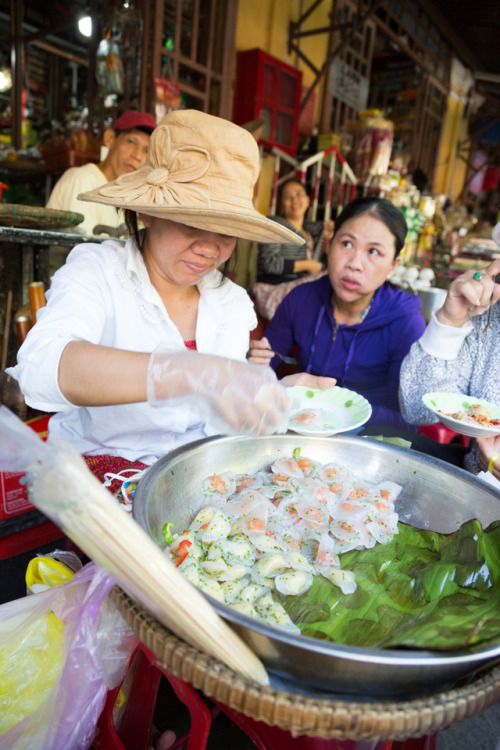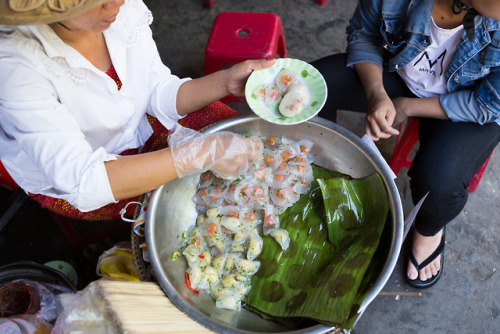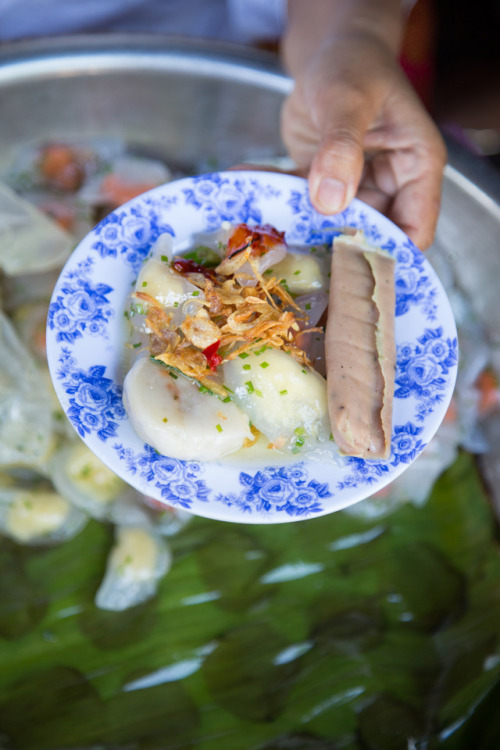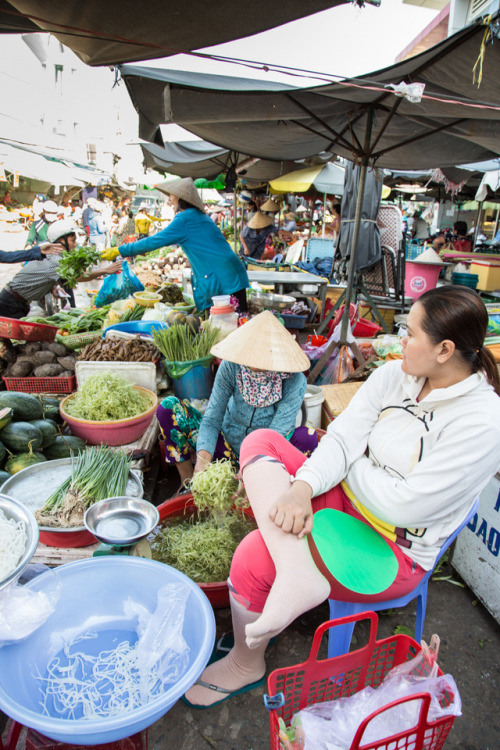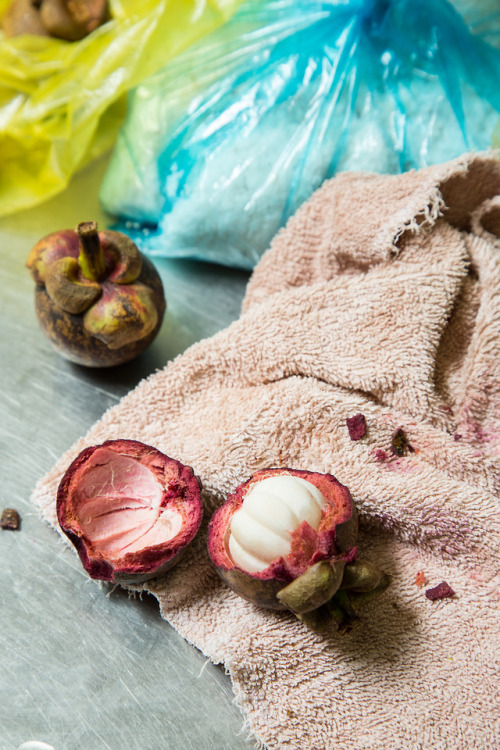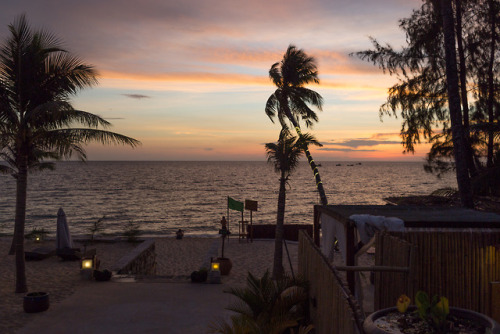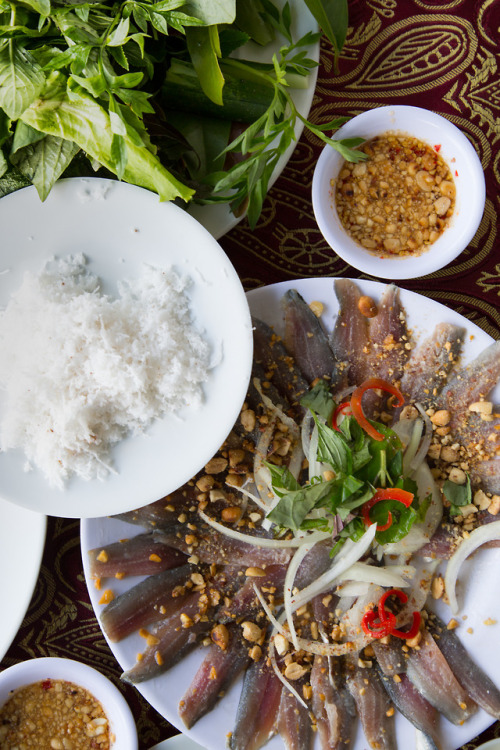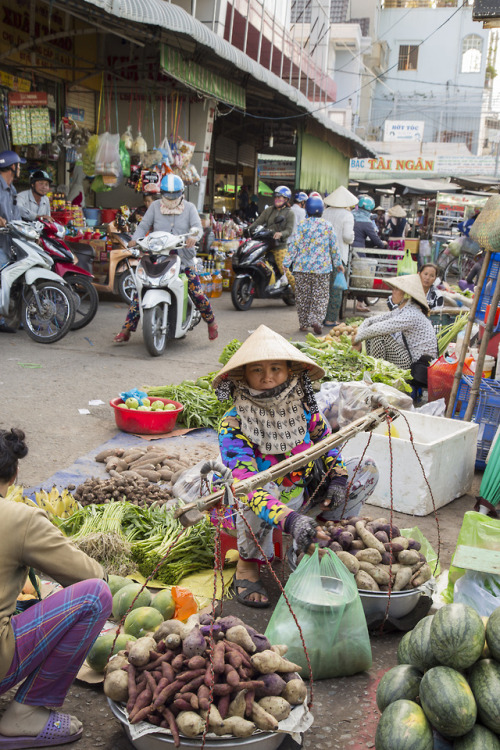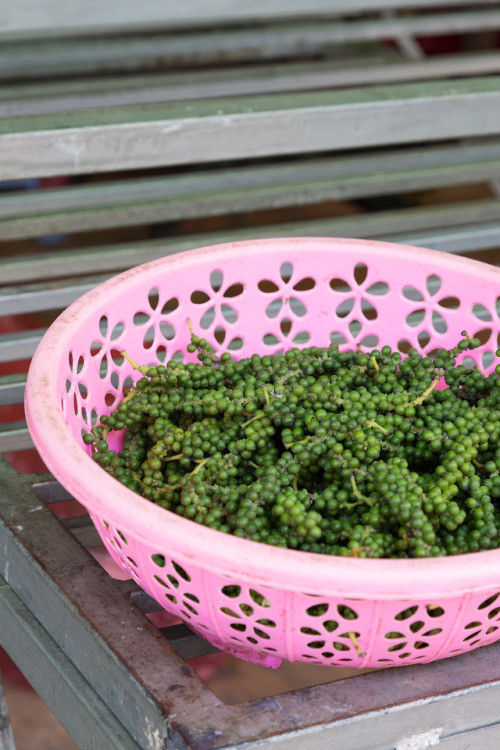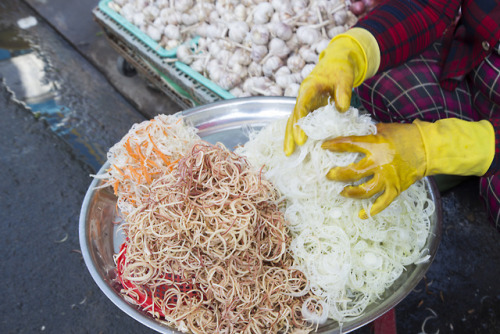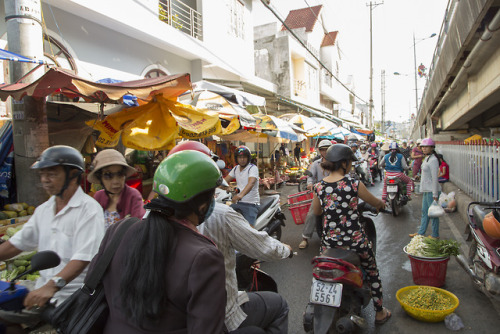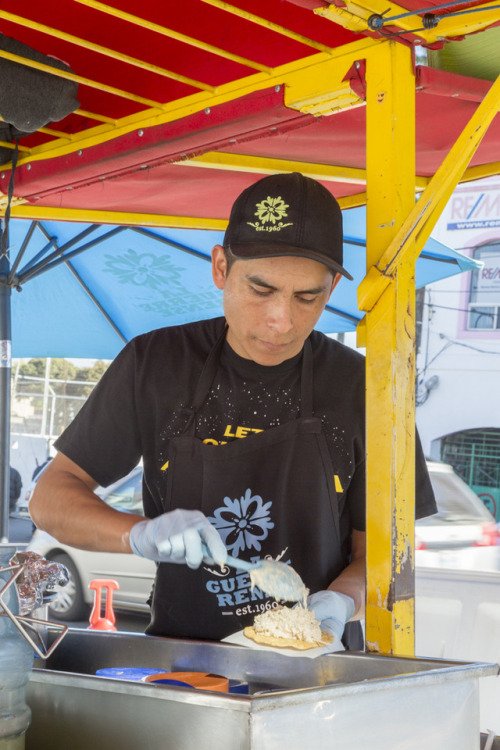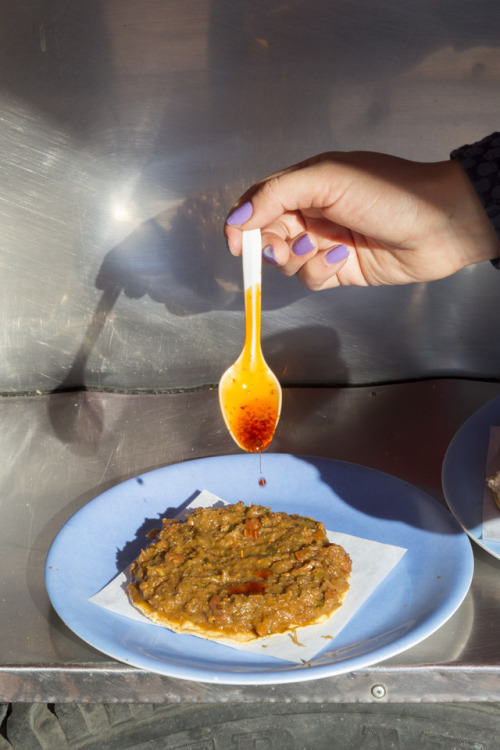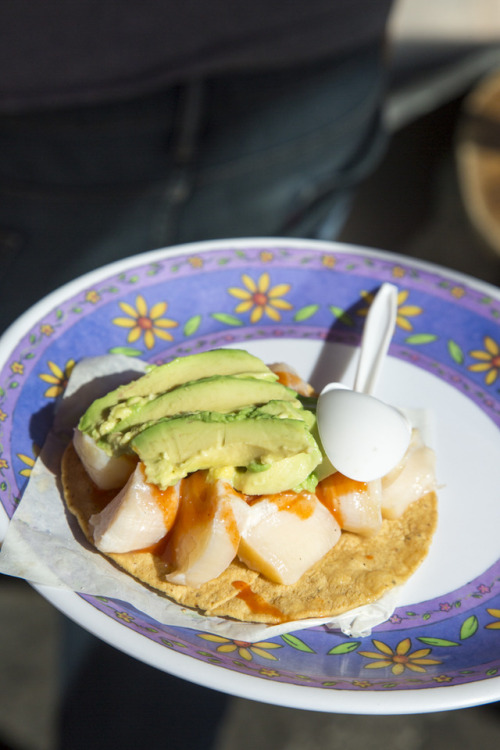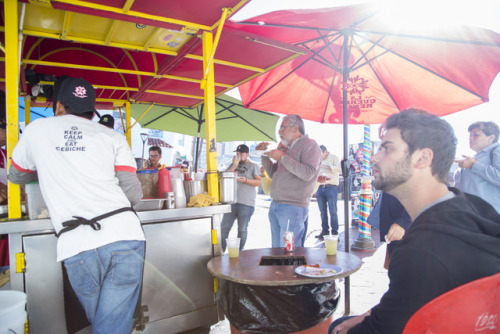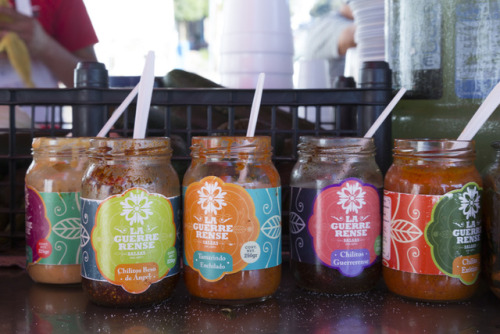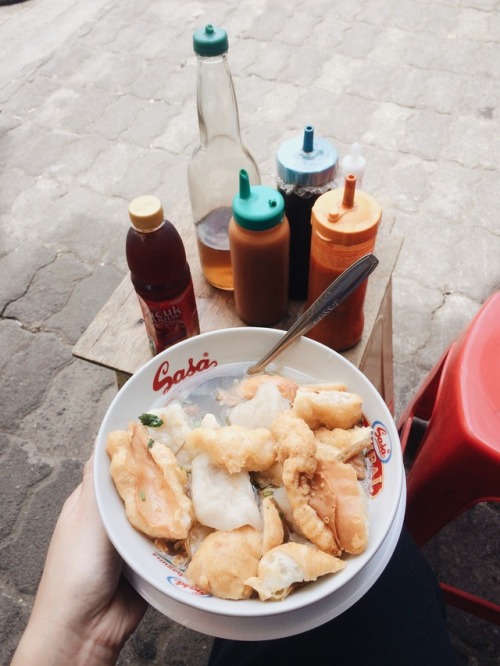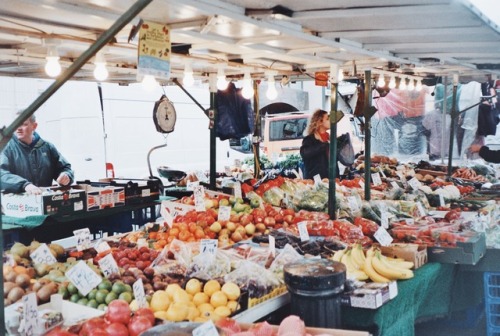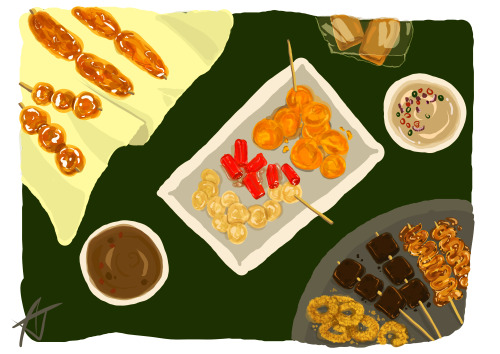#street food
Rose: Dumplings: The Street Food Of Your Dreams
Location: Hoi An, Vietnam
We did it. We found the perfect street food.
There is a dumpling that far surpasses all the rest. It is chewy, and light, fragrant and bit-sized. It is the Vietnamese rose dumpling, made with chewy tapioca and rice noodle skin, filled with shrimp or fresh bean paste. They are topped with toasted crispy garlic and served with a dipping sauce made from flavorful shrimp broth, hot chilies, lemon, and sugar. They are so elegant, it’s hard to imagine they are being served on the street corner fora dollar a serving.
In the open air markets of central Vietnam, dense clusters of women squat on low stools, singularly focused on the tiny bowls cradled in their palms. Look for a large metal pot in the center of these parties, that’s always a good sign. And try them all, each vendor we patronized had their twist, their own variation on the filling, the chile sauce, even the shape of the dumplings themselves. It’s a wonderful world out there, start eating!
Post link
Paradise at the Southern Tip of Vietnam
Location: Phu Quoc, Vietnam
It’s no secret, we travel to eat. But sometimes, we also take advantage of incredible beaches and the heavenly climate too. We began our trip to Vietnam in the congested and chaotic city of Saigon, but we soon diverted to the southern most tip of the country, to a magical island called Phu Quoc. Here, the palm trees curve off the white sand beaches towards the turquoise water. The roofs are thatched, the fruit and vegetables exotic, and the vibe is laid back.
The coast of the island is a destination for resort life, but in the interior of the island, there is an incredible concentration of bustling produce and fish markets. The inner and outer rings of this tiny island could not be held in greater contrast. So when we tired of sunsets and sipping coconuts, we ventured into the open air market, which was anything buttranquil.
We grapevined through the scooters and dense corners of women wearing mismatched, psychedelically printed pajamas, squatting on neon plastic stools. Some were selling shimmering fresh fish, others peeling mystery vegetables into impossibly thin ribbons, using only the most crude kitchen tools to great effect. We purchased raw anchovies, filleted and laid flat (a local delicacy), and clustered vines of fresh green peppercorns, another specialty from this island. They were floral, intense and the kind of thing you just want to add to every and any dish, forevermore. We shopped till we dropped, and brought our bounty back to the kitchen to make fresh coconut rice cakes, herb chicken salad, and topped those fresh anchovy fillets with tons of herbs, dried coconut and toasty peanuts.
Post link
Say It Three Times Real Fast, and Lick Your Lips: La Guerrerense
Location: Ensenada, Mexico
In our opinion, making delicious food is as simple as finding the right combination of fresh ingredients to pair with tasty, spicy, innovative sauces. La Guerrerense tostada stand in the heart of Ensenada gets that equation right every time. We should know, we only ate there five times in three days.
The cart is the brainchild of Sabina Bandera, a petite woman with close cropped grey hair and a smile from ear to ear. She reigns over her empire of street food and packaged salsas, maintaining military order so that raw shellfish can be shucked à la minute, tostadas drizzled with oil-based cacoa nib salsa, and coctelesof pismo clams doled out to devoted fans. If you’re not into raw seafood like sliced scallops and sea snails, you’re crazy, but, there are cooked options as well. We fell for the smoked fish paté tostada, with a flavor profile that was completely different from what you expect in Mexico - meaty smoked fish is stewed in a tomato base with green olives, onions, marjoram and oregano, to make a deep, complex spread. After all, we are just south of California, so olive trees grow here, and olive oil is the staple cooking oil.
The seafood selection changes daily, but you can always count on those thrilling salsas. Our favorite was a bright orange pineapple sauce, and an oil-based salsa macha, made with whole peanuts and crushed dried chiles. This is not your mother’s salsa, but instead, a whole new texture and eating experience. We were so inspired, we created a Mexican Chile Oil. Lucky for you, it’s available now on our Destination Salad menu.
Post link
#TummyTales: Cuanki time is best time
Bandung’s culinary scene is weird. There’s fried yeast covered in eggs (cilor) and its siblings (cilok, cimol, and cireng). Nobody thought they’d like it, but they snack on these weird babies anyway. I can honestly say I have been personally victimized by this.
Cuanki is another one. It’s short for “cari uang jalan kaki” which literally means “find money by walking”. Mostly because cuanki sellers usually carry their products using a rod and walk around the area.
It’s still a popular way for them to be found, but this cuanki has grown to an actual shop. Its HQ is always filled with people queuing and it’s crazy! But at the market I usually go to, they have their own mini branch. Sold by this guy with his own pushcart, stools are used as makeshift tables.
It’s become one of my must-haves when I’m in Bandung because it’s warm, salty and crispy. Do yourself a favor and save yourself the queue and head to the Cuanki Serayu pushcart at Pasar Cihapit. It’s quieter, colder, and easier to find parking.
Post link
One of my favorite taco spots in Mexico City is El Vilsito, the auto garage that turns into one of the city’s most beloved underground street food vendors at night. But it looks like the secret is now out as they were just featured on the premiere episode of Netflix’s Taco Chronicles! Here’s a quick look at my last visit…

I mentioned a while back that I may from time to time, post a non Thai recipe so hope it’s okay that today I’m making a short hop over the border into Malaysia. Some of you may remember I went on holiday for a few weeks last year to Kuala Lumpur and Langkawi where I spent as much time as possible eating my way through dishes from all the cultures that call Malaysia home.
My husband and I particularly enjoyed the simple rice dishes that we ate for breakfast, such as nasi lemak and this one; nasi goreng kampung (village style fried rice). Although it looks quite a straightforward dish it’s full of very strong flavours; notably salty, fishy and spicy ones. Treat yourself and top your portion off with a freshly cooked crisp fried egg.
For 4 large portions use:
- A large bowl of cold, pre cooked rice
- a large bunch of morning glory (water spinach) cut into 2 inch pieces
- a handful of green beans, cut into small pieces
- 2 large handfuls of dried crispy anchovies (1 handful finely chopped, 1 left whole)
- 4 red chillies, finely chopped
- 4 cloves garlic, finely chopped
- 2 large eggs, beaten
- 1 small onion, finely sliced
- a big glug of light soy sauce
- a big squeeze of kecap manis (sweet, dark, thick soy sauce)
- vegetable oil for frying
In a deep wok, heat the oil until hot and fry the onion, garlic and chillies until they have some colour (about 2 minutes). Stir fry in the handful of chopped anchovies and green beans (open a window/put on the extractor!), frying for a minute before moving the ingredients to the side of the wok and pouring in the beaten egg. Let the egg begin to set before lightly scrambling. Let it set again, scramble, set, scramble until fully cooked and mix all the ingredients back together. Throw in the morning glory, briefly stir frying for a minute before carefully tipping all the rice in.Pour over the sauces and gently toss and mix all the ingredients, making sure all the rice is well coated and heated through. Have a taste to see if it needs any more sauce and plate up, sprinkling the other handful of dried fish over the steaming rice.
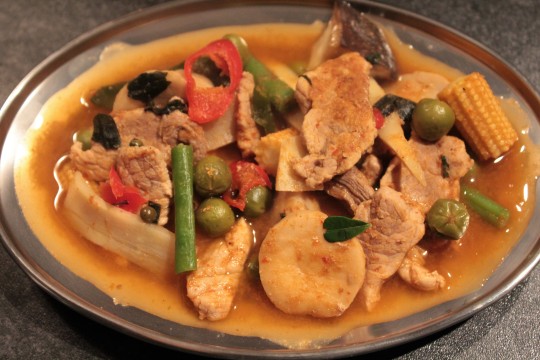
Like any recipe, over time you make amendments and adaptations, you find better ways to make a dish or variety of ingredients that have a better ‘fit’ and are truer to the authentic version of a dish.
This is one such recipe- way, way back in June 2014, jungle curry was one of the first recipes I put up on my blog-
click here for beef jungle curry
However, despite being my favourite type of Thai curry, it was always one I felt I couldn’t quite do justice to and wasn’t as good as I wanted it to be. Over the last couple of years I’ve been fiddling with both the way the curry is cooked and the ingredients.
Jungle curry, is a northern Thai curry, heavy on the vegetables, typically one of the hotter Thai curries and is made without coconut milk. If you like spicy hot, herbal flavours with lots of crunchy textures, you’ll love Gaeng Pa. It’s very easy to do. It’s also easily adaptable to be a vegetarian dish- just add more of the meaty king oyster mushrooms and substitute the fish sauce for a big pinch of salt.
So may I present the upgraded- Gaeng Pa Moo (Pork jungle curry)…
This make four portions:
- 300g of lean pork, sliced thinly
- 5 baby corn cobs, cut into chunks
- a small handful of green beans, cut into chunks
- a large handful bamboo shoots, drained and rinsed
- 2 king oyster mushrooms, cut into wedges
- a large handful of pea aubergines/eggplants
- a large red chilli, sliced
- 3 fingers of krachai (finger root), finely shredded
- a tablespoon of green peppercorns
- a handful of holy basil (or sweet basil- but NOT Mediterranean basil!!)
- a few kaffir lime leaves, ripped into small pieces
- a large tablespoon of red curry paste (I use Mae Ploy brand)
- 300ml of meat stock
- a small splash of fish sauce
- a small pinch of palm sugar (or light brown sugar)
- Heat the stock in a pan (no wok needed for this recipe) until simmering. Add in the pork; it’s thinly sliced so will cook quickly, in around 2 minutes.
- Add in the red curry paste and stir until thoroughly mixed into the stock.
- Add in the lime leaves and krachai strips, which will start to infuse into the broth.
- Next pop in the chunkier vegetables; green beans, pea aubergines, baby corn cobs and bamboo shoots, let them cook down for a few minutes then add in the king oyster mushrooms, green peppercorns, sugar and fish sauce.
- Cook for a few more minutes, stirring every so often; the vegetables should still retain some crunch.
- Just before serving, stir in the basil and chilli slices and serve with rice.
Nepali Paan…ingredients: betel nut & other stuff…like custom blended chewing tobacco…yummo!
Source: Zacapatista (2009)
Post link

